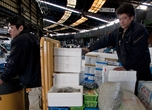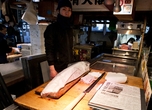
Ganso Nikumaki Honpo (Left/right: Nikumaki. Center: Cheese Nikumaki)
Posted: Wed Feb 24 2010
Mention Japanese cuisine, and sushi, soba, tempura and sukiyaki tend to spring to mind— in fact, ‘sushi’ is so well known that the word itself is now recognised all over the world. Yet as any visitor knows, with dishes like ramen, Japanese curry and rice bowls, Japanese fare incorporates a wide variety of foods and flavours. Emphasising affordability and popular appeal, B-kyu-gurume (B-class gourmet) is the term used when referring to these simple, hearty foods, and in some cases, regional variations given a new twist.
Despite current economic conditions, government data suggests that per capita, the amount of money spent on eating out in Japan has actually increased. Japan has no doubt earned dining kudos because of its Michelin status, but the real word on the street is B-kyu-gurume. So popular is B-kyu that there even exists an annual ‘Local B1 Grand Prix’, where different regional dishes are pitted against each other to win prizes.
This eating boom underway, B-kyu-gurume restaurants– some of which claim heritage status in their respective hometowns– are now popping up in Tokyo by the dozen. Listed below are six of the finest, offering great tasting food at cheap-as-chips prices.
Nikumaki-onigiri specialist
Ganso Nikumaki Honpo Shimokitazawa branch
Erudite folk could probably tell you that Miyazaki is known for killer shochu (an alcoholic spirit commonly distilled from either sweet potato, rye, black sugar or buckwheat), once boasted comedian Kokubaru Higashi as mayor and is believed to be home to the Gods who created Japan. But if really onto it, they’ll already know about Ganso Nikumaki Honpo and their famous ‘nikumaki-onigiri’. Just as the name implies, nikumaki onigiri consists of thinly sliced pork wrapped around rice balls. Extremely moreish, the meat is marinated for twenty-four hours in a ginger-tanged secret sauce. The snack’s origin bears repeating: the chain’s owner once worked in an izakaya that served rolled tonkatsu (deep friend pork cutlets) to complement its drink menu. The meat off-cuts were often given away as freebies to the staff; kitchen experimentation took place and nikumaki were born. Wishing to spread the word about Miyazaki pork, Ganso Nikumaki Honpo was established and soon became the talk of the town. It’s a formula that works: Tokyo’s Shimokitazawa branch is thriving, the most popular offerings at ¥300 apiece are regular nikumaki and a cheese topping version—the cheese toasted with a gas burner right before your eyes.
Address: Shimo-Kitazawa Platz 1F, 2-7-5 Shimo-Kitazawa , Setagaya, Tokyo
Telephone: (03)5790 9703
Open: Mon-Thur & Sun 11am–1am; Fri-Sat & days before nat. holidays 11am–2am
Note: open only whilst stocks last.
Website: www.nikumaki.com/
Karaage specialist
Ganso Nakatsu Karaage Moriyama, Gakugei University branch
Many Japanese love their KFC, but we’re more enamoured with homegrown karaage (deep fried chicken), said to originate from Nakatsu, Oita, when local government policy encouraged the development of poultry farming. According to one theory, it was the then recent Second World War returnees from Manchuria, who, wishing to recreate the style of chicken they’d eaten in China, adopted deep-frying it. Nowadays, there are so many local karaage specialist restaurants, all of who tend to compete by producing their own original flavours. ‘Ganso Nakatsu Karaage Moriyama’ is no exception and adds touches of garlic and salt to produce a variant that goes particularly well with beer. Menu experimentation continues with a whole range of different karaage on offer including karaage made from meat on the bone, fillets, wings and cartilage. Lunch sets, karaage sandwiches and chicken skin crackers round off the menu. As each order is fried individually, be sure to visit with plenty of time on your hands.
Address: 1F, 2-8-21 Takaban, Meguro, Tokyo
Telephone: (03)3719 5730
Open: 11am–10pm
Website: morikara.net/
Tamago kake gohan specialist
Tamagonchi, Hibiya branch
A few years ago, a specialist soy sauce for tamago kake gohan (egg sauce over rice) hit the market. Astute operators grabbed opportunities to help revive local towns through cuisine, and various tamago kake gohan specialist restaurants were born. One such store, ‘Tamagonchi‘, opened a Tokyo branch last year. This B-kyu-gurume stalwart serves nikoen (a famous variety of high quality chicken eggs) from Toyama with Koshihikari (a famous variety of high quality rice) from Nagano together with miso soup and tsubu-nori (shredded seaweed) for ¥305. Topping options include shirasu (whitebait), okura (okra), natto (fermented soybeans), and tororo (grated yam) among others.
Address: UN building 1F, 1-2-15 Yurakucho, Chiyoda, Tokyo
Telephone: (03)5251 8645
Open: Daily 7am–11pm
Website: niko-en.co.jp/
Sanuki udon specialist
Akasaka Mentsudan
In addition to their bustling Nishi-Shinjuku branch, Mentsudan– debated as largely responsible for the current sanuki udon boom– has now opened a branch in Akasaka. The noodles are delivered directly from Miyatake Sanuki Seimenjo in Sanuki, Kagawa Prefecture, and the Akasaka branch is already attracting extra attention by stocking what, according to Sanuki HQ, looks set to be the next wave of the boom— slightly thinner than usual udon noodles.
Address: Continental Akasaka Five Bldg. 1F, 3-12-3 Akasaka, Minato, Tokyo
Telephone: (03)3588 1615
Open: Mon-Fri 11am–4am, Sat-Sun & nat. holidays 11am–11pm
Website: www.mentsu-dan.com/
Takoyaki specialist standing bar
Tsukiji Gindaco Highball Sakaba
No doubt Tokyoites are already familiar with takoyaki (fried octopus dumplings) establishment ‘Tsukiji Gindaco’, which counts approximately three hundred stores in Japan alone. Something new on parent company Hotland’s menu however is ‘Tsukiji Gindako Highball Sakaba’: a standing bar where you can enjoy takoyaki whilst drinking. Specialty takoyaki varieties distinguish the menu here– Cheese Fondue Takoyaki and Mentaiko (Cod Roe) Takoyaki only two of the versions on offer– designed to be washed down with assorted soft drinks or alcoholic beverages aka the ‘Kaku Highball’ and ‘Premium Maltz Beer’. Younger clientele are also catered for with the opening of ‘The Gindaco’ on Omotesando in Harajuku, the ‘Takoyaki Burger’ and ‘Omutako’ (an egg-wrapped version) popular items for fuelling local shopping sprees.
Tsukiji Gindako Haiball Sakaba, Shinjuku Kabukicho branch
Address: 1-18-6 Kabukicho, Shinjuku, Tokyo
Telephone: (03)5155 2227
Open: Mon-Fri 12noon–5am, Sat-Sun & nat. holidays 11am–5am
The Gindaco
Address: Dai5 Suwa Bldg. 1F/2F, 1-14-24 Jingumae, Shibuya, Tokyo
Telephone: (03)5775 1788
Open: 11am–10pm
Website: www.hotland.co.jp/english/
White taiyaki specialist
Taiyaki Shiroya, Asagaya branch
Taiyaki Shiroya specialises in shiro-taiyaki— a white variety of taiyaki (fish-shaped sweet filled pancakes) thought to have originated in Fukuoka prefecture. By adding tapioca powder to the mix, they create a dough that is both soft and springy, their shiro-taiyaki so good that they can be enjoyed either hot or cold. As well as traditional anko (bean jam) fillings, they also offer shiro-anko (white bean jam), kuro-goma (black sesame flavour), custard, chocolate, green tea, and various other seasonal varieties. Unique takes are the shiro-yaki with no filling at all and a new variety that’s eaten with soy sauce.
Asagaya
Address: 1-4-1 Asagaya-kita, Suginami, Tokyo
Telephone: (03)3310 7515
Shimo-Kitazawa
Address: 2-34-10 Shimo-Kitazawa, Setagaya, Tokyo
Telephone: (03)6416 8536
Website: www.taiyaki-shiroya.com/
Related articles:
・Tokyo for free
Enjoying the city for nothing
・Free beauty spots
Stay beautiful for free in cash strapped times
・Tokyo’s cheap eats
4 spots to grab a bite without blowing your wallet
Tweets
- About Us |
- Work for Time Out |
- Send us info |
- Advertising |
- Mobile edition |
- Terms & Conditions |
- Privacy policy |
- Contact Us
Copyright © 2014 Time Out Tokyo














Add your comment